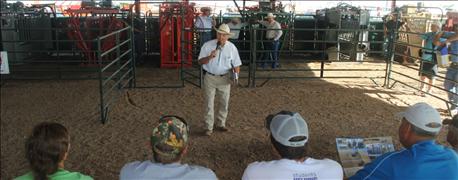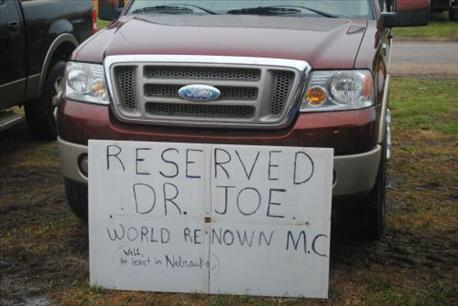
There is nothing like being first. Husker Harvest Days was one of the first farm shows in the country to introduce live cattle-handling demonstrations to the schedule. Today, live cattle handling at HHD, sponsored by Vesta, Minn.-based Rio Nutrition, is one of the show's most popular events.
According to legendary Lexington veterinarian and demonstration narrator, "Dr. Joe" Jeffrey, side-by-side comparisons of cattle chutes along with explanations by company representatives make the demonstrations useful to producers. Then, seeing the chutes in action as cattle are being processed helps producers make their own decisions about the chutes that work best for their operations.

ENTERTAIN AND INFORM: Dr. Joe Jeffrey, Lexington, has been engaging and educating audiences at live cattle handling at HHD for 27 years.
The 2015 show marks the 27th year of live cattle handing at HHD. Because of advances in processing chutes and equipment, the demonstrations run like clockwork, with pens and alleys designed for the safety of the audience, the cattle and chute operators.
Jeffrey has been a part of cattle handling at HHD since the beginning. Along with his experiences with cattle health as a veterinarian and working in the family beef operation, he also brings a form of downhome humor audiences truly enjoy. The concept for side-by-side chute comparisons and live-cattle handling developed around Jeffrey's kitchen table, in a discussion between Jeffrey and Tim Talbott, who worked for Big Valley.

DR. JOE PARKING ONLY: Jeffrey is a well-known speaker and rural entertainer, traveling the region for shows and demonstrations, like HHD cattle handling.
"It has been a lot of fun," says Jeffrey, who uses humor to engage and inform the audiences. "The real heroes of the demonstrations are the guys operating the chutes. The chutes have really improved," he says. "The greatest changes have been how strong the chutes are built today and how much safer they are for livestock and the handlers."
The first demonstrations were held under a rather small tent, with only two sets of bleachers, before a spacious permanent structure was completed in 1991. Located on Lot 860 in the Livestock Industry Building at the corner of Eighth Street and West Avenue, they have always been situated amidst livestock exhibits, breed association displays and beef related equipment and machinery.
~~~PAGE_BREAK_HERE~~~
After the first year of demonstrations, Talbott filed a prophetic report, saying that cattle-handling had the potential to become a "major draw" for HHD. In fact, Talbott explained that more room would be needed in future years to accommodate an increased number of chute and animal health companies that would be involved, along with larger audiences. This prophecy has come to pass, with several sessions taking place before standing-room only audiences.
President of Rio Nutrition, Trevor Greenfield, says the demonstrations offer ranchers the opportunity to see equipment and livestock in action, under real conditions. "It's a good place for ranchers to see new ideas and some of the solutions manufacturers bring to the table," Greenfield says. "We bring most of our team to the show and we enjoy meeting ranchers face to face, so we can understand their needs, challenges and goals," he says. "That's our top priority."
So, don't miss the HHD demonstrations of chutes, vaccination and implanting devices, scheduled daily at 10 a.m. and 2 p.m.
Ralph Cornelius of Alda is carrying on a family tradition by providing cattle for the exhibition. Within the working facility complex, producers can also talk with sales representatives from the manufacturers of fencing, livestock panels, buildings and facilities, livestock waterers, feeding systems and haying equipment about their newest product lines.
About the Author(s)
You May Also Like






